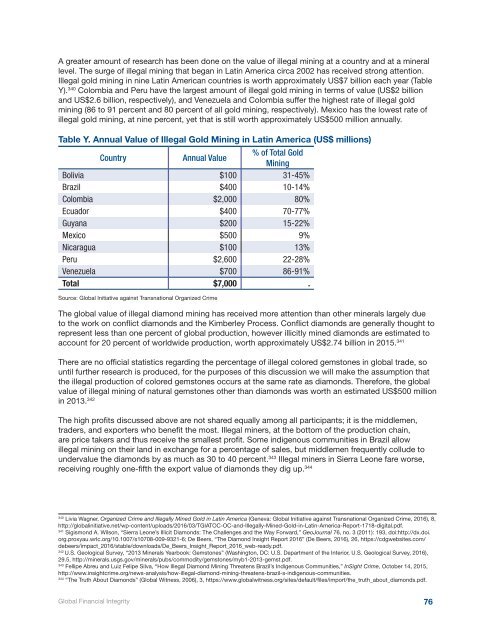Transnational Crime and the Developing World
Transnational_Crime-final
Transnational_Crime-final
Create successful ePaper yourself
Turn your PDF publications into a flip-book with our unique Google optimized e-Paper software.
A greater amount of research has been done on <strong>the</strong> value of illegal mining at a country <strong>and</strong> at a mineral<br />
level. The surge of illegal mining that began in Latin America circa 2002 has received strong attention.<br />
Illegal gold mining in nine Latin American countries is worth approximately US$7 billion each year (Table<br />
Y). 340 Colombia <strong>and</strong> Peru have <strong>the</strong> largest amount of illegal gold mining in terms of value (US$2 billion<br />
<strong>and</strong> US$2.6 billion, respectively), <strong>and</strong> Venezuela <strong>and</strong> Colombia suffer <strong>the</strong> highest rate of illegal gold<br />
mining (86 to 91 percent <strong>and</strong> 80 percent of all gold mining, respectively). Mexico has <strong>the</strong> lowest rate of<br />
illegal gold mining, at nine percent, yet that is still worth approximately US$500 million annually.<br />
Table Y. Annual Value of Illegal Gold Mining in Latin America (US$ millions)<br />
Country<br />
Annual Value<br />
% of Total Gold<br />
Mining<br />
Bolivia $100 31-45%<br />
Brazil $400 10-14%<br />
Colombia $2,000 80%<br />
Ecuador $400 70-77%<br />
Guyana $200 15-22%<br />
Mexico $500 9%<br />
Nicaragua $100 13%<br />
Peru $2,600 22-28%<br />
Venezuela $700 86-91%<br />
Total $7,000 .<br />
Source: Global Initiative against <strong>Transnational</strong> Organized <strong>Crime</strong><br />
The global value of illegal diamond mining has received more attention than o<strong>the</strong>r minerals largely due<br />
to <strong>the</strong> work on conflict diamonds <strong>and</strong> <strong>the</strong> Kimberley Process. Conflict diamonds are generally thought to<br />
represent less than one percent of global production, however illicitly mined diamonds are estimated to<br />
account for 20 percent of worldwide production, worth approximately US$2.74 billion in 2015. 341<br />
There are no official statistics regarding <strong>the</strong> percentage of illegal colored gemstones in global trade, so<br />
until fur<strong>the</strong>r research is produced, for <strong>the</strong> purposes of this discussion we will make <strong>the</strong> assumption that<br />
<strong>the</strong> illegal production of colored gemstones occurs at <strong>the</strong> same rate as diamonds. Therefore, <strong>the</strong> global<br />
value of illegal mining of natural gemstones o<strong>the</strong>r than diamonds was worth an estimated US$500 million<br />
in 2013. 342<br />
The high profits discussed above are not shared equally among all participants; it is <strong>the</strong> middlemen,<br />
traders, <strong>and</strong> exporters who benefit <strong>the</strong> most. Illegal miners, at <strong>the</strong> bottom of <strong>the</strong> production chain,<br />
are price takers <strong>and</strong> thus receive <strong>the</strong> smallest profit. Some indigenous communities in Brazil allow<br />
illegal mining on <strong>the</strong>ir l<strong>and</strong> in exchange for a percentage of sales, but middlemen frequently collude to<br />
undervalue <strong>the</strong> diamonds by as much as 30 to 40 percent. 343 Illegal miners in Sierra Leone fare worse,<br />
receiving roughly one-fifth <strong>the</strong> export value of diamonds <strong>the</strong>y dig up. 344<br />
340<br />
Livia Wagner, Organized <strong>Crime</strong> <strong>and</strong> Illegally Mined Gold in Latin America (Geneva: Global Initiative against <strong>Transnational</strong> Organized <strong>Crime</strong>, 2016), 8,<br />
http://globalinitiative.net/wp-content/uploads/2016/03/TGIATOC-OC-<strong>and</strong>-Illegally-Mined-Gold-in-Latin-America-Report-1718-digital.pdf.<br />
341<br />
Sigismond A. Wilson, “Sierra Leone’s Illicit Diamonds: The Challenges <strong>and</strong> <strong>the</strong> Way Forward,” GeoJournal 76, no. 3 (2011): 193, doi:http://dx.doi.<br />
org.proxyau.wrlc.org/10.1007/s10708-009-9321-6; De Beers, “The Diamond Insight Report 2016” (De Beers, 2016), 26, https://cdgwebsites.com/<br />
debeers/impact_2016/stable/downloads/De_Beers_Insight_Report_2016_web-ready.pdf.<br />
342<br />
U.S. Geological Survey, “2013 Minerals Yearbook: Gemstones” (Washington, DC: U.S. Department of <strong>the</strong> Interior, U.S. Geological Survey, 2016),<br />
29.5, http://minerals.usgs.gov/minerals/pubs/commodity/gemstones/myb1-2013-gemst.pdf.<br />
343<br />
Fellipe Abreu <strong>and</strong> Luiz Felipe Silva, “How Illegal Diamond Mining Threatens Brazil’s Indigenous Communities,” InSight <strong>Crime</strong>, October 14, 2015,<br />
http://www.insightcrime.org/news-analysis/how-illegal-diamond-mining-threatens-brazil-s-indigenous-communities.<br />
344<br />
“The Truth About Diamonds” (Global Witness, 2006), 3, https://www.globalwitness.org/sites/default/files/import/<strong>the</strong>_truth_about_diamonds.pdf.<br />
Global Financial Integrity<br />
76


